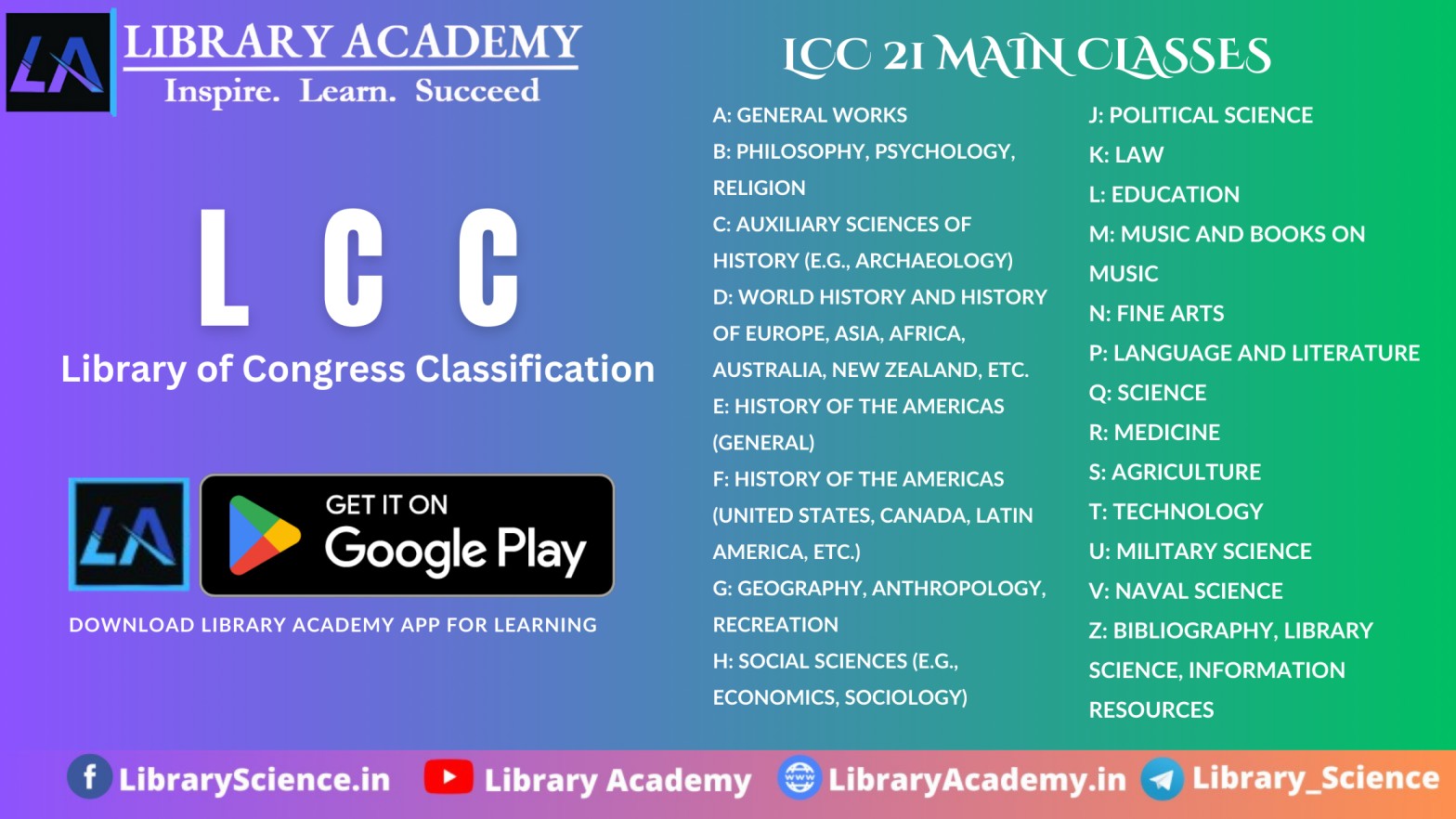Overview of Library of Congress Classification (LCC)
The Library of Congress Classification (LCC) is a system used by most research and academic libraries in the United States of America (USA) to organize their collections of books and other materials. LCC is an enumerative Classification System.
Library of Congress Classification was developed by JCM Hanson & Charles Martel with assistance from Charles Martel, in 1897, while they were working at the Library of Congress. It is designed to provide a comprehensive and flexible framework for classifying knowledge systematically and logically.
Here are some key points about the Library of Congress Classification system:
Structure of LCC: The LCC system divides knowledge into 21 broad categories, each represented by a letter of the alphabet. Most of these alphabetical classes are further subdivided into more specific sub-classes identified by combinations of two or sometimes three letters. For instance, class N, Art, has sub-classes NA, Architecture; NB, Sculpture, ND, Painting; and several other sub-classes.
Main Classes of Library of Congress Classification
The Library of Congress Classification (LCC) system is organized into 21 main classes, each designated by a letter or a combination of letters. 21 main classes of the LCC:
A: General Works
B: Philosophy, Psychology, Religion
C: Auxiliary Sciences of History (e.g., Archaeology)
D: World History and History of Europe, Asia, Africa, Australia, New Zealand, etc.
E: History of the Americas (General)
F: History of the Americas (United States, Canada, Latin America, etc.)
G: Geography, Anthropology, Recreation
H: Social Sciences (e.g., Economics, Sociology)
J: Political Science
K: Law
L: Education
M: Music and Books on Music
N: Fine Arts
P: Language and Literature
Q: Science
R: Medicine
S: Agriculture
T: Technology
U: Military Science
V: Naval Science
Z: Bibliography, Library Science, Information Resources
The LCC helps libraries maintain consistency in classification and ensures that users can easily find materials on related subjects.
Read More: 1. DDC Classification. 2. UDC Classification
Notation of LCC: The Library of Congress Classification (LCC) uses a combination of letters and numbers to create a unique call number for each item in the library’s collection.
For example, the subclass QA represents Mathematics under the broader category Q for Science.
Flexibility: The system is designed to be flexible and expandable to accommodate new fields of knowledge and changes in existing fields.
Call Numbers of LCC:
- Call numbers in the LCC consist of a combination of letters and numbers.
- Example: QA76.73.P98 signifies a book on the Python programming language (QA for Mathematics, 76 for Computer Science, 73 for Programming Languages, P98 for Python).
Usage: The LCC system is widely used by academic and research libraries, including the Library of Congress itself, to organize and provide access to their collections.
The LCC helps libraries maintain consistency in cataloging and ensures that users can easily find materials on related subjects.
Frequency Ask Question (FAQ) on Library of Congress Classification (LCC)
Here are some frequently asked questions (FAQ) about the Library of Congress Classification (LCC):
FAQ on Library of Congress Classification (LCC)
1. What is the Library of Congress Classification (LCC)?
The LCC is a system used to organize and arrange books and other materials in libraries, primarily used by academic and research libraries in the United States. It categorizes knowledge into 21 main classes, each represented by letters and numbers.
2. How is the LCC different from the Dewey Decimal Classification (DDC)?
The LCC uses a combination of letters and numbers to create call numbers, while the DDC primarily uses numbers. The LCC is more commonly used in academic and research libraries, whereas the DDC is often used in public and school libraries.
3. How do I read an LCC call number?
An LCC call number typically consists of letters representing the broad subject category, followed by numbers for more specific topics, a Cutter number for the author or title, and sometimes the publication date. For example, “QA76.73.J38 2020” represents a book on Java programming published in 2020.
4. Why is the LCC system important for libraries?
The LCC system provides a structured and systematic way to organize library collections, making it easier for users to find materials and for libraries to manage their collections efficiently.
6. Can the LCC system accommodate new subjects?
Yes, the LCC system is designed to be flexible and expandable, allowing for the inclusion of new subjects and changes in existing fields as knowledge evolves.
7. Is the LCC system used outside the United States?
While the LCC is primarily used in the United States, many libraries worldwide also use it, especially academic and research libraries.
8. How are subclasses identified in the LCC system?
Subclasses in the LCC system are identified by combinations of letters and numbers. For example, class N (Art) is divided into subclasses such as NA (Architecture), NB (Sculpture), and ND (Painting).
9. How do libraries assign LCC call numbers to books?
Libraries assign LCC call numbers based on the subject matter of the book, using the classification schedules published by the Library of Congress. Catalogers analyze the content of the book and assign the appropriate class, subclass, and Cutter number.
Summary: The Library of Congress Classification (LCC) organizes library materials into 21 classes, using letters and numbers for precise categorization, primarily used in academic and research libraries.
Please Download the Library Academy App for Preparation for Various Librarian Exams: Click Here
 Subscribe YouTube Channel
Subscribe YouTube Channel

